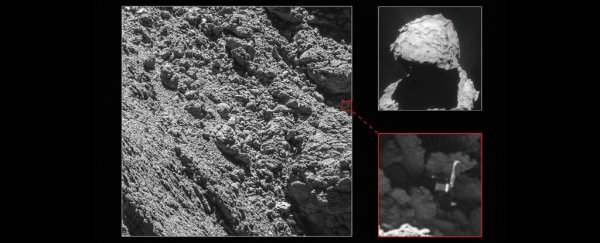Two years after the Philae lander made history by crash-landing on comet 67P, its final resting place has been discovered, and it's, well, a little disturbing.
New images from Europe's Rosetta space probe have revealed that since Philae went into hibernation in 2014, it's been wedged upside-down inside a dark crack on the comet's surface, with two of its three legs sticking out.
It's not the most dignified end for Philae - being stuck face-down in a ditch for as long as it takes all that steel and titanium to break down in the near-vacuum of space - but at least it didn't get thrown into the Solar System's incinerating machine aka Jupiter.
And now we know we can always visit, even if comet 67P is often hundreds of millions of km away from us.
"For many people it is a huge emotional closure," Mark McCaughrean, senior scientific adviser at the European Space Agency (ESA), which owns both Philae and Rosetta, told Nicola Davis at The Guardian.
"But for the scientists, it is incredibly important, because it now tells us where the measurements were taken that we made with Philae back in 2014 - that context is everything."
 ESA/Rosetta/MPS for OSIRIS Team MPS/UPD/LAM/IAA/SSO/INTA/UPM/DASP/IDA
ESA/Rosetta/MPS for OSIRIS Team MPS/UPD/LAM/IAA/SSO/INTA/UPM/DASP/IDA
On 12 November 2014, Philae did what no other robotic spacecraft has ever managed to do - after a 6.5-billion-kilometre journey piggybacking on Rosetta, it detached itself, and began its 7-hour descent towards comet 67P, which was travelling at roughly 250 km/h, or 70 m/s.
Upon landing, Philae bounced twice, and ended up in the shadow of a cliff, which meant there was not enough light to charge its solar panels.
Its power ran out about 57 hours after it landed, but six months later, when comet 67P made its approach towards the Sun, Philae spluttered into life once more - but only long enough to send a message home before falling back into hibernation.
And now we know where that hibernation is taking place.
"We had some images from further away that looked a bit like the lander, but we really needed this unambiguous [image]," said Matt Taylor, ESA's Rosetta project scientist. "We needed that to say 'Yes, it is definitely Philae.'"
The good news is Philae will soon have some company in its retirement. The bad news is, umm, Rosetta, you're cool with a desolate grave on an icy space rock, right?
"As Comet 67P heads away from the Sun and towards the orbit of Jupiter, there will be less and less solar energy available to power Rosetta and its instruments," Jennifer Ouellette reports for Gizmodo. "So mission planners will crash the probe into the comet in a slow, controlled descent on September 30."
And just as Philae's crash-landing was one of the most complex feats of human engineering ever performed, Rosetta's will be an even more incredible achievement.
"What we are doing at the moment is actually more complicated than when we deployed Philae itself," Taylor told The Guardian, adding that finding Philae was a nice little bonus as they're planning to put the mission to bed.
"I think it is a nice prelude for the end of the mission," he said. "It's bloody exciting."
